8 Countertop Edge Styles To Consider In Your Remodel, According To Designers
Designers say this detail can have a big impact in your kitchen or bathroom.
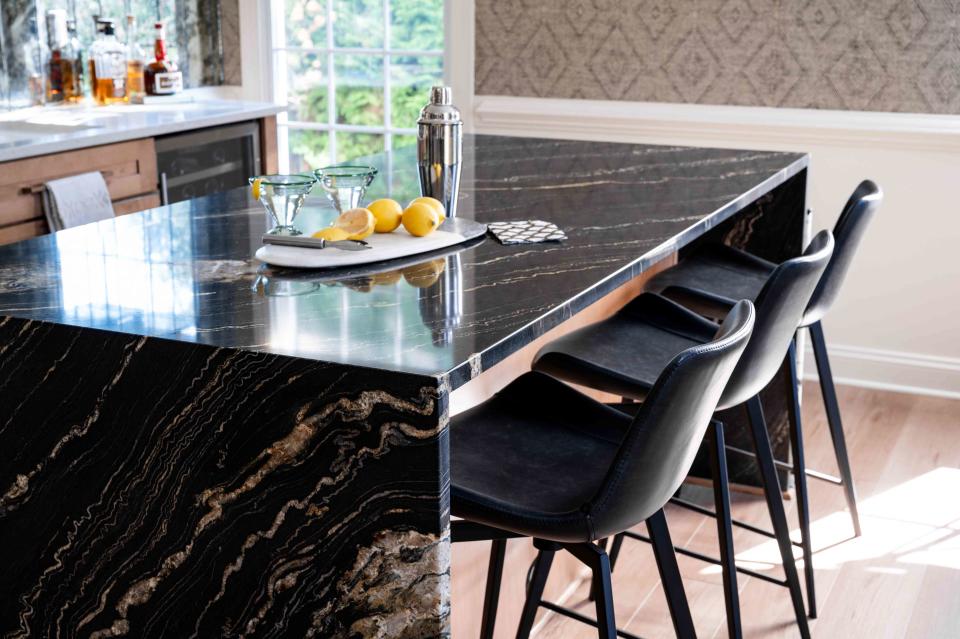
Courtesy Jenn Cameron Interiors
Marble, quartz, or granite? As it turns out, that isn’t the only question to ask when remodeling a countertop. After choosing a stone, some of the South’s top interior designers remind us not to overlook the details. Specifically, they warn against falling into the common mistake of ignoring the edges. There are several countertop edge styles to choose from—each offering a distinct stylistic and functional purpose.
“It’s the small details that matter,” says interior designer Stephanie Abernathy. “Depending on preference, pairing a simple counter profile with a more ornate edge style or a more architecturally complicated cabinetry style with a simple edge profile helps cut down on visual clutter and can be a supporting actor to the main headliner.”
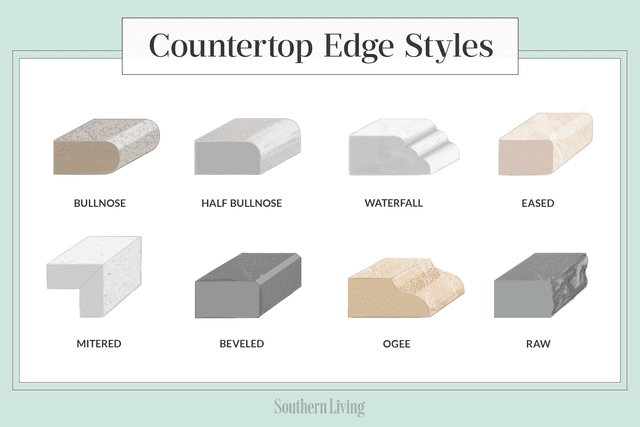
Grace Canaan
Meet the Experts
Stephanie Abernathy is the principal designer of Studio Wellington in Atlanta, Georgia
Jenn Cameron is the principal designer of Jenn Cameron Interiors in Baltimore, Maryland
Stephanie Pohlman is the principal designer of Stephanie Pohlman Designs in Saint Charles, Missouri
For many folks, countertop edges are a detail they’ve never stopped to notice—an unsung hero that contributes to the beauty of the overall space. Well, if you haven’t noticed them before, you sure will from here on out. Here’s everything to know about countertop edge styles, trends, upkeep, and professional insight to decide which is right for your kitchen or bathroom remodel.
Bullnose Edge
Classic, rounded bullnose edges are an elegant countertop style well-suited for longevity. Interior designer Jenn Cameron recommends this style for family households with traditional design preferences.
“These are considered more traditional in style with softer edges and are less prone to damage over time,” she explains. “They’re also great for families with young children if they are concerned about sharp edges.”
However, because the edges are rounded, designer Stephanie Pohlman notes that it’s not so easy to sweep crumbs tidily off the counter with your hand. Other countertop edge styles are better suited to easy cleaning.
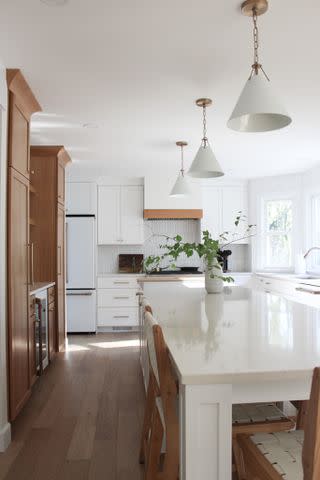
Courtesy Stephanie Pohlman Designs
Eased EdgeEased Edge
Pohlman’s favorite style, eased edges, are characterized by soft, square edges. They are noted for their simplicity, timeless style, and easy-to-clean functionality.
“Eased edge is the most simple and easy to clean. Most of my clients have families so that is important to them,” Pohlman says. “Eased edge is just a softer kind of square profile, so it makes it easy to wipe clean and brush any crumbs into your hands without getting caught in anything. It's just very simple and pretty practical.”
Abernathy agrees that eased edge countertops are a “classic style. They’re simple, a safe choice, and one we often use to get a clean look in a classical home. When used in 2-centimeters, they remind us most of beautiful antique furniture.”
Half Bullnose Edge
A half bullnose edge can be identified by its gentle curve. While some styles, like eased edges, can suit nearly every countertop, designers agree that a half bullnose edge should only be applied in some instances.
Cameron notes that a half bullnose edge is ideal for highlighting the thickness of a stone countertop in small kitchens where the last thing you want to do is worry about slamming your side into a sharp edge. “This edge style also helps spills fall onto the floor, rather than onto cabinets,” she says.
However, Pohlman worries that in larger spaces where the countertop has more room to make an impression, a half bullnose edge won’t be the right look and can diminish the look of natural stone.
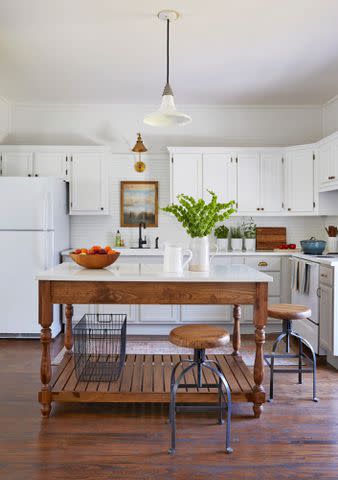
Ogee Edge
This more decorative style takes on an S-shaped profile marked by two curves in the countertop edge. Like a bevel edge, ogee edges require a bit more attention while cleaning and don’t make it as easy to simply brush off crumbs over the counter and into your hand. However, in spaces such as large, simply decorated kitchens, this stylish edge can still be more than worth it for the look alone.
“An ogee edge is dramatic,” Cameron says. “I would make sure to keep other elements in the kitchen more simple to balance it.”
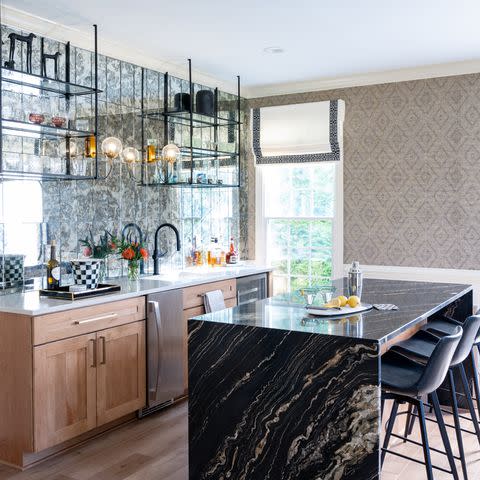
Courtesy Jenn Cameron Interiors
Waterfall EdgeWaterfall Edge
“I love waterfall edges,” Pohlman says. “It’s a very modern look.”
Rather than ending like a tabletop, waterfall edges round over and continue down to the floor. This means that counters with a waterfall edge require more stone so they will often be more expensive than other styles. Plus, Polman reminds us that though they’re beautiful, waterfall edges cover at least two sides of the counter, meaning there’s less potential storage space. Meaning, this style is usually better suited for big kitchens, usually with modern design and ample storage.
“Waterfall edges can often be earmarked for the modern or contemporary home, but in our opinion they are perfect to get a clean space with a bit of drama,” says Abernathy. “However, waterfall edges can still feel classical if paired with the right cabinetry style.”
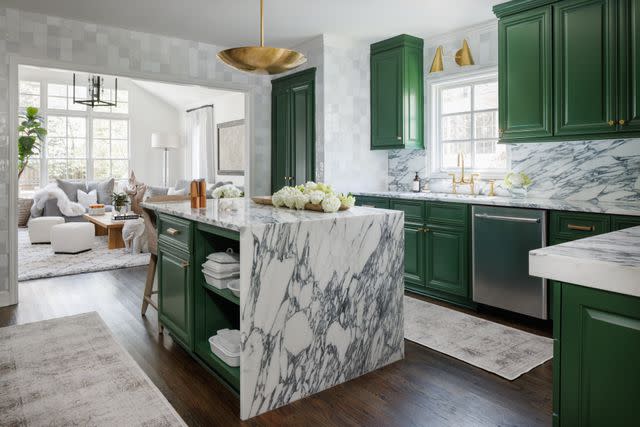
Lauren Chambers; Design by Stephanie Abernathy for Studio Wellington
Waterfall Edge island and Mitered Edge countertopMitered Edge
Mitered edges are created when two 45-degree edges are fastened together to form a clean-cut 90-degree corner. Designers note that mitered edges are the way to go for a high-end, modern, and clean look.
While Cameron says that a mitered edge can transform a countertop into a statement piece all on its own, Abernathy shares that flourishes, such as scallops, reeds, or fluting, can be added for an even-more eye-catching mitered edge.
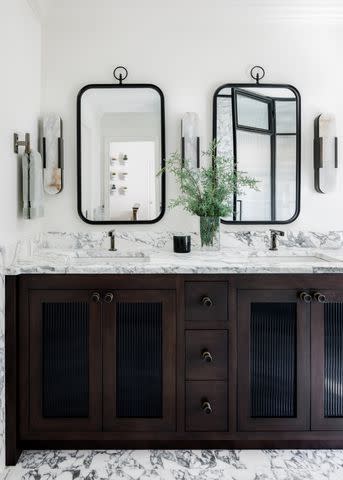
Lauren Chambers; Design by Stephanie Abernathy for Studio Wellington
Raw EdgeRaw Edge
With all of these highly stylized countertop edges to choose from, Abernathy begs us not to forget about the most obvious, understated option: a raw edge. Characterized by its rough, lived-in appearance, this style evoked natural beauty.
“Raw edges feel super organic and look amazing when paired with clean lines or something a bit more architecturally traditional,” says Abernathy.
However, countertops with these edges are not literally “raw." Often, raw edges are thoughtfully chiseled to achieve this look.
Bevel Edge
For a more ornate look, a bevel edge is a more expensive and stylish option to suit both modern and traditional rooms. Bevel edges feature a 45-degree angle that packs a big design punch.
Pohlman shares that bevel edges are edgy—both in style and sharpness. Because of their signature bevel, cleaning the counter requires an extra flourish to make sure no cribs are stuck on the sloped edge.
Frequently Asked Questions
What is the most popular countertop edge style?
Eased edges are the most popular countertop edge style, as well as designers’ go-to. Cameron, Abernathy, and Pohlman all rank this style as their #1 choice, with mitered edges and waterfall edges tied for second favorite when they want some extra pizazz.
Can you mix different edge styles on your countertops?
“Yes, definitely,” says Cameron. “In fact, it makes the space more interesting!”
Across rooms, there’s no need to stick to just one style. Your kitchen countertops can totally have a different edging than those in your bathroom. For adjacent surfaces, Pohlman recommends keeping it simple with just one or two styles and choosing to divert sparingly. For example, she says that the kitchen island is a great place to switch up the edges for an instant statement-maker.
Are certain edge styles more suitable for specific countertop materials?
Consult your manufacturer or installation professional to ensure that your stone of choice is compatible with your selected countertop edge style. For example, mitered edges are not ideal for every type of stone. Quartzite, especially more crystallized quartzites, don’t tend to miter well, according to Abernathy.
How do you maintain and clean different countertop edge styles?
Clean your countertop edge the same as you would the rest of the counter. The necessary maintenance is determined more by the type of stone than the edge style. However, edge styles with slopes, nooks, and crannies may need a bit or extra attention to make sure that crumbs and bacteria don’t linger.
Is it possible to change the edge style of an existing countertop?
Technically yes, but it’s not so easy or economical. Consult a counter fabrication expert to inquire about your specific countertop’s possibilities.
For more Southern Living news, make sure to sign up for our newsletter!
Read the original article on Southern Living.

